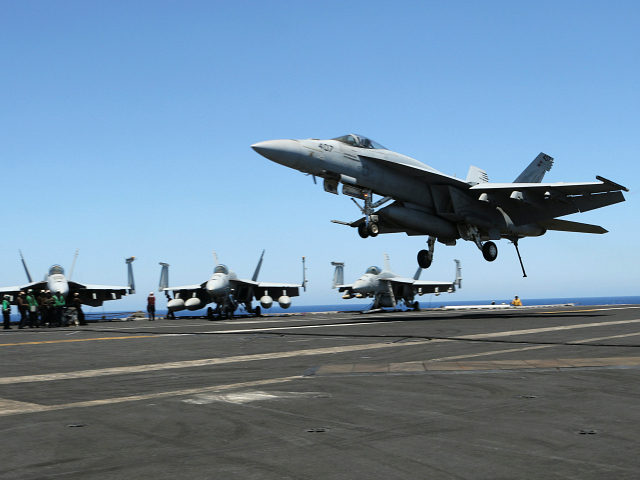Military budget cuts have led to overused planes and undertrained pilots, a move that has fueled a “sharp increase” in aviation accidents, some fatal, during training exercises at home, reports Stars and Stripes, citing data it has obtained from the Naval Safety Center.
The data from the Norfolk, VA-based center shows that, “since 2012, the number of major Navy and Marine [F/A-18] Hornet and Super Hornet accidents — incidents causing at least $50,000 in damage and in some cases leading to injury, death or the loss of the $60 million aircraft — skyrocketed 44 percent.”

Leaders from the Navy and its Marine Corps component warned lawmakers last year that budget cuts would affect non-deployed units, which includes those who are undergoing training within the United States.
Military leaders also warned that the budget constraints could end up costing U.S. military lives during major conflict.
“The losses happened, but not in combat. Pilots died training at home,” notes Stars and Stripes, adding:
Since May, four F/A-18 Hornet or F/A-18E/F Super Hornet crashes involving nondeployed units killed two pilots and destroyed five planes.
The crashes are the latest in a sharp increase in military aviation accidents overall for nondeployed squadrons, which have absorbed the bulk of budget cuts through reduced training and delayed maintenance at home so the best aircraft and personnel can be used on the front lines.
In 2011, Congress passed the Budget Control Act that instituted automatic federal spending cuts known as sequestration. By March 2013, the across-the-board cut to all spending programs started to take effect.
According to the Government Accountability Office (GAO), the Pentagon’s operations and maintenance account, which covers expenses linked to training and repairs on aircraft, lost $20.3 billion in 2013 alone.
“It’s extremely clear what’s happened,” California-based Navy F/A-18E/F Super Hornet pilot Lt. “Versace,” who asked to be identified by his call sign only because he was not authorized to speak about the issue publicly, told Stars and Stripes. “These aircraft have reached their life span and they continue to extend their life spans for another few thousand flight hours, which hasn’t worked for them due to significant budget decreases. Yet they continue to run these jets that have caused catastrophic incidents.”
Stars and Stripes explains:
The Navy and Marines rank their aviation accidents as mishaps, with the top three most damaging as Class A through C. Class A is the highest level of crash and means a pilot was killed or permanently disabled or the aircraft sustained at least $2 million in damage.
Since sequestration, the number of Class A through C mishaps involving Hornets or Super Hornets has climbed from 57 in fiscal year 2012 to 82 as of Aug. 2 of this fiscal year, according to data from the Naval Safety Center.
Not only Hornets or Super Hornets have been affected. Across the board, the number of Navy and Marine aircraft lost in accidents has doubled during the first 11 months of fiscal year 2016 compared to the same time in 2015. Twenty aircraft had been destroyed as of Aug. 29, compared to 10 aircraft during the same time in 2015, according to Naval Safety Center data obtained by Stars and Stripes.
Some Navy and Marine leaders sounded the alarm earlier this year about the link between the spike and accidents and pilots being required to fly fewer hours resulting in undertrained personnel.
“Regrettably… you’re going to see [nondeployed] pilots that aren’t flying very much,” Rear Adm. Michael Manazir, director of Navy air warfare, told the Senate Armed Services Committee in April.

COMMENTS
Please let us know if you're having issues with commenting.